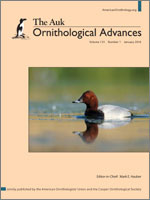Niche construction can lead to coevolutionary episodes and greater specialization, and can have implications for the evolution of biological diversity, so understanding how individuals adjust their behavior to conspecifics and heterospecifics over changing social and environmental gradients presents an interesting research problem. The objective of our study was to test the hypothesis that mixed flocks of gulls and diving ducks congregate as a result of interacting over food. Ducks are vectors that carry zebra mussels (Dreissena polymorpha) up from the bottom of a water body, and gulls consume this type of food. We investigated the interactions of 2 gull species with 3 benthivorous duck species—Common Pochard (Aythya ferina), Tufted Duck (A. fuligula), and Greater Scaup (A. marila)—in the Szczecin Lagoon, Poland. We found that the presence of gulls in duck flocks was closely correlated with foraging by ducks. Eighty-four percent of foraging duck flocks (>5% of the flock members were foraging) and 52% of nonforaging duck flocks (<5% of the flock members were foraging) were accompanied by gulls (Fisher's exact test, P = 0.008). The odds ratio showed that every 10% increase in the number of foraging ducks doubled the chance of gulls being present (odds ratio of 10% unit change = 2.058). We defined the relationship between the size of the foraging duck flock and the number of gulls present in it; the number of gulls rose with increasing numbers of ducks in the flock. All our findings confirmed that this gull–duck co-occurrence was the result of interaction over food (commensalism or interspecific kleptoparasitism). We showed that the diet of gulls in the Szczecin Lagoon changed dramatically when Aythya ducks made their appearance; after duck arrival, gull pellets contained almost exclusively mussels. Our results reveal that the trophic relationship between zebra mussels and the studied bird species is not just a straightforward one between predator and prey.
How to translate text using browser tools
4 November 2015
Newly demonstrated foraging method of Herring Gulls and Mew Gulls with benthivorous diving ducks during the nonbreeding period
Dominik Marchowski,
Łukasz Jankowiak,
Dariusz Wysocki
ACCESS THE FULL ARTICLE

The Auk
Vol. 133 • No. 1
January 2016
Vol. 133 • No. 1
January 2016
A. fuligula
A. marila
Aythya ferina
Dreissena polymorpha
foraging strategy
mixed-species flocks
zebra mussel




